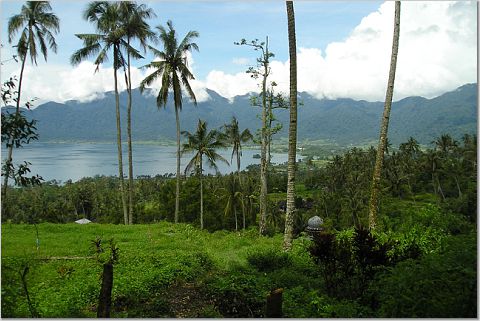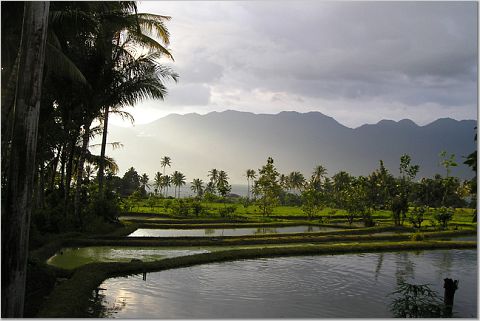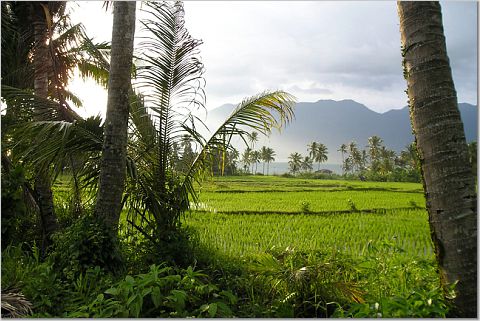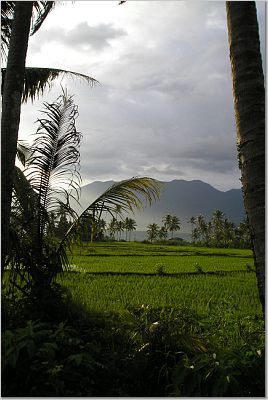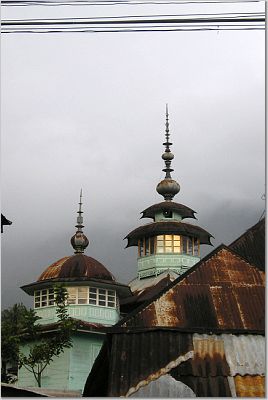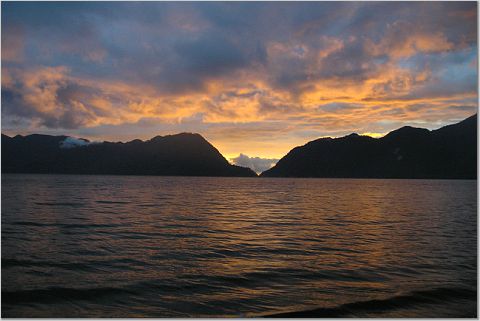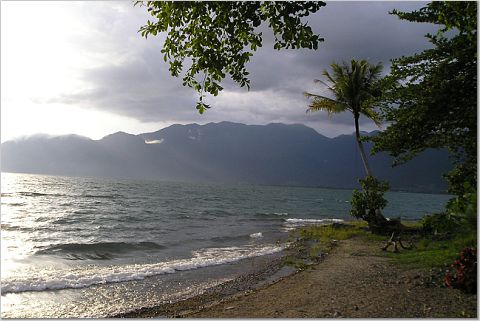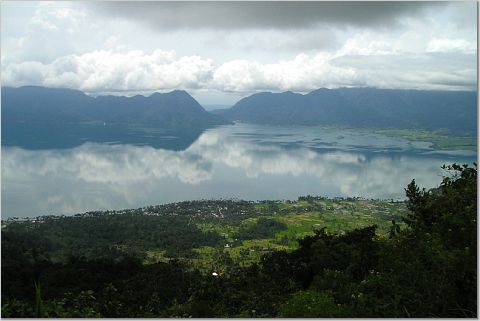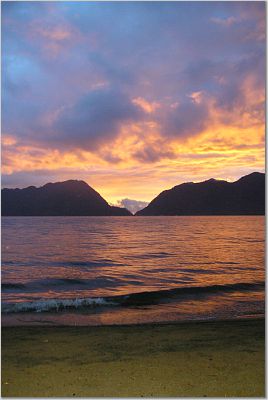Archive for March, 2006
Lake Toba, Sumatra
Wednesday, March 1st, 2006My mother was the reason I was in Sumatra. She retired young and spends the winters traveling around Asia. “Why not meet up in Lake Toba?” she had suggested. Why not?
Romlan (run by a German lady) consists of 8 large and comfortable bungalows with hot running water. The setting is spectacular; I would wake up every morning to views of the lake from my bed. The water was a dark marine blue. A few kilometers away the mainland rose spectacularly out of the lake, a rugged line of steep green cliffs between the blues of water and sky. Everything was eerily quiet. Flowers flourish everywhere; reds, yellows and violet adding colour to the green lushness that seems to have overtaken the island. Even the cement stairs down to the hotel’s jetty had been taken over by green moss.
As hilly as Tuk-Tuk is, it is the flattest part of Samosir. It is actually a small peninsula sticking out from the rest of the island. Behind it, the land rises to heights of about 700 meters, a sheer wall of green cliffs and waterfalls that seems to encircle the entire island. The town itself is a collection of homes, hotels, restaurants and shops lining the road that follows the shoreline around the peninsula. My readings somehow made Tuk-Tuk sound very touristy; I guess if you compare it to other places in Indonesia that might be the case – but after Thailand I found it incredibly peaceful and quiet (I saw about 5 other tourists in town in the five days spent in Lake Toba). Most buildings were built of wood, 1 or 2 story buildings topped with traditional Batak roofs. Establishments are family owned – a friendly man rented about 3 motorcycles and 5 mountain bikes from a small stand off the road. Across the street his wife had a tiny little bookstore, tattered books lining uneven shelves. The bookstore was next to a guesthouse that they also ran, their young daughters helping the mother in the kitchen. Down the street was what was to become our favourite restaurant – the Marco Polo restaurant – where we sat in bamboo chairs looking out over the lake while the lady fixed us guacamole sandwiches. Two small boys, her sons, brought us a puppy, shy smiles on their faces. Seven other puppies slept next to their mother under a chair. I noticed that Tuk-Tuk was full of babies; little kids, puppies, kittens, piglets, and chicks everywhere. Lake Toba seemed to be a garden of Eden.
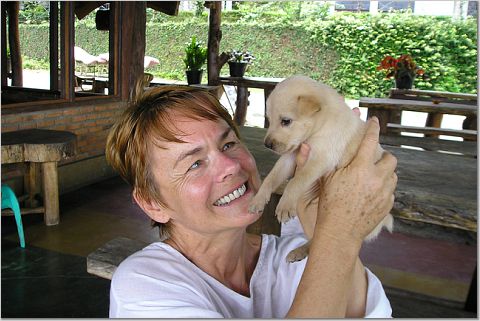
We would walk down the road, people looking up from whatever they were doing to smile and wave at us. It was hard to associate these friendly, outgoing people with their somewhat fierce reputation. The Bataks are believed to have migrated here from northern Thailand centuries ago. While the rest of Sumatra became increasingly influenced by Islam, the mountains kept the Bataks isolated both geographically and culturally – they maintained their animist beliefs, unique architecture, and arts and crafts. They were among the most warlike people of Sumatra and were so mistrustful of others that they did not maintain paths between villages or construct bridges. They are also infamous for having practiced cannibalism on criminals and enemies. Villagers, starting with the chief, would cut meat off the victim while they were still alive and would devour it raw. Cannibalism was, for the most part, stopped when the Bataks were converted to Christianity in the 19th century although the rules were relaxed somewhat when the Japanese invaded Sumatra during WWII – I guess nobody really liked the Japanese and eating them seemed like a good idea at the time.
Saturday market
Saturday is market day in Parapat, the town on the side of the crater just a short ferry ride from Tuk Tuk. The usual quiet and empty square next to the pier is suddenly loud and bustling, the town, for this one day, being the congregation point for villagers from the surrounding region. Strange smells waft through the air. Goods are spread out on the ground, some directly on the cement, others on sheets – dried noodles, fruits (oranges, rambutan, pineapples, mangos), dried fish and prawns, vegetables, live chickens in baskets, fresh fish in buckets, others being gutted alive on the ground. Men sold bottles of rice whiskey. Also on sale were durians, the famously bad smelling fruit. Many describe the smell of durians; “rotting onions”, “unwashed socks”, “carrion in custard”, “a sewer full of rotting pineapples.” They’re being politically correct. Durians smell like fresh diarrhoea, that’s what they smell like. That’s why they’re banned in hotels, buses, trains, taxis, and airplanes. I saw many signs in Sumatra (usually in hotels) prohibiting durians from their premises during our travels.

We came back on a full ferry. A girl approached me “Excuse me sir, I am English teacher. Can I speak with you in English?” I said yes, only to find out that the girls seated with her were her students – for the next half hour we were surrounded by 20 or so giggling girls speaking to us in halting English; “Where you from? Do you like Indonesia? What are your hobbies? (a seemingly usual question in Asia, I get asked that all the time) Do you have wife? Why not?” I was photographed with each girl at least 3 times. A grizzled-looking older man approached me “Can I speak English with you?” I found out that he had a brother in the USA that he wanted to visit “I want to visit Nebraska. It looks very beautiful.” What are the odds of meeting a guy in the middle of Sumatra who wants to visit Nebraska of all places?
Around Samosir on motorbike
One of the great pleasures on Samosir was driving around on the motorcycle. The roads around Tuk-Tuk are in good shape and almost completely devoid of other vehicles. The distances are also long enough that the motorcycle was useful for daily tasks such as going to the internet café (Toba Cottages has a decent connection) or picking up supplies around town. It was also great for exploring – we drove to Ambarita, about 5 km away, my mother holding on in the back. It was a charming town with parks, a church, and a school; we arrived just as school finished, the road full of chattering kids in red and white uniforms. Driving back, we almost crashed into a huge water buffalo that suddenly decided to sprint across the road; I like to think I looked like James Bond accelerating past the horns, doing a near wheelie with my mom on the back…
I talked my mother into touring the island of Samosir. “A road in a reasonable state of repair follows the coast…” says one guidebook. The road is “not so good” says another. Again, I was to find out that the guidebooks had abandoned Sumatra at around the same time that the tourists had. After 20 minutes the road became a riverbed of large boulders. We bounced around on the motorcycle. Half an hour later we were at the top. The views were spectacular. The problem here was mud. We got stuck and my mother fell off the bike into the mud. 10 minutes later we had a flat back tire. I pushed the motorcycle 3 kilometres in the direction of Tuk-Tuk. “This ain’t no *^&*% road!” My mother got angry because I was swearing. We passed tiny villages where kids would see us coming and run for the safety of their homes.
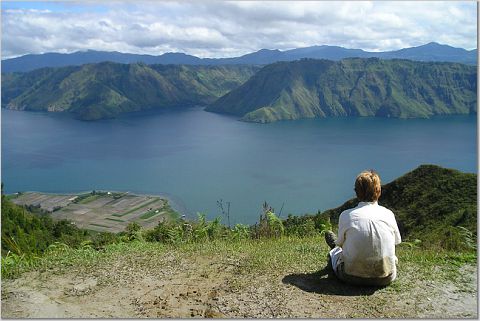
“Hello, I am mechanic! Me good mechanic.” A man was peering over a fence at us. “Come, I help! I am good mechanic!” Our saviour took over our bike, removed the back wheel and replaced the lining – within half an hour our bike was fixed. His pregnant wife and 3 kids came to look in on us, the wife inviting us to tea, the kids staring at us as if we were aliens. They started to cry when I came too close.
We left Lake Toba the next day, our heads full of memories of incredibly friendly people and beautiful scenery. It is not an easy destination to get to – Sumatra is for the thick-skinned, adventurous traveller. But once there you will not be disappointed. Lake Toba is the jewel of Sumatra.
My mother had gone back to Lake Toba for Christmas 2004. She was in her room at Romlan meditating when the earthquake struck on December 26. There was a lot of shaking (“It made me sick to my stomach”) but incredibly Lake Toba suffered no damage whatsoever.
Getting there: Most international connections through Penang or Kuala Lumpur. Air Asia by far the cheapest flight into Medan. Ferries can also be taken from Penang to Medan.
Accommodation in Lake Toba: recommend Romlan and Carolina’s.
Shopping: Batak wood carvings are the thing to get here. You won’t find any better or cheaper anywhere in Sumatra. Batak music is also great – actually quite Latin sounding with its flutes.
When to go: Avoid rainy season (October to April.) Rains are worst in the early part of the season.
Hiking: see rainy season..good hiking on Samosir, but dangerous in the rainy season when it gets very muddy (leeches a distraction as well..)
Not only was it peaceful, it was very cheap; my room was 35,000 rupiahs a night (about $4.50 Canadian) A large meal – and Romlan had a great kitchen serving German and Indonesian food – would come out to about the same. Beer was the most expensive thing, a large Bintang beer would come out to 15,000 rupiahs ($2). Actually, everything in Lake Toba was cheap; I rented a Honda motorcycle during my stay which cost 40,000 rupiahs a day ($5 Cad) I calculated that I averaged about 150,000 rupiahs a day in Lake Toba, that’s about $20 Canadian (approx. $17 USD).

